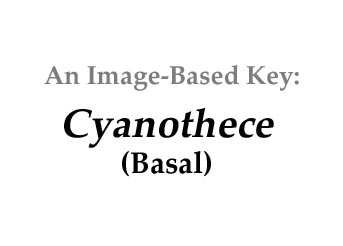|
Home / Cyanobacteria / unicells / Cyanothece |
||||
|
|
||||
|
|
||||
|
|
||||
|
Click on images for larger format |
||||
Name derivation: |
||||
Classification: |
||||
Cyanothece Komárek 1976; 8 of 17 species descriptions are currently accepted taxonomically (Guiry and Guiry 2013)Order Chroococcales; Family CyanobacteriaceaeConsidered a synonym of Synechococcus
|
||||
Morphology: |
||||
|
Cells vary from oval to cylindrical, from 3 to 100 µm long, with little or no evident mucilage exterior. Color varies from cyano to green, pink or purple. May be present in groups of cells.
|
||||
Diel metabolic cycling: |
||||
Nitrogenase cannot function to ‘fix’ nitrogen in the presence of O2. Some filamentous cyanobacteria (e.g. Anabaena, Aphanizomenon, etc.) produce specialized cells with barriers against inflow of external O2 and elimination of intracellular O2 by respiration (heterocysts). Unicellular diazotrophic cyanobacteria such as Cyanothece use a different strategy, ‘fixing’ nitrogen only at night after metabolizing or releasing intracellular O2. Diurnal photosynthesis cycles with nocturnal nitrogen fixation (Schneegurt et al. 1994, Bandyopadhyay et al. 2013). The diel cycling is accompanied by day/night changes in gene expression and protein production (Stöckel et al. 2011; Aryal et al 2011). In effect the cells are aerobes by day and anaerobes by night.Apparently all photosynthetic bacteria have a two-component regulatory system acting as a signal transducer to switch between PS + CO2 assimilation versus nitrogen fixation (Joshi and Tabita 1996). Redox potential rises with PS and falls with N-fixation. |
||||
Similar genera: |
||||
|
Cyanobium Rippka and Cohen-Bazire 1983
|
||||
Habitat: |
||||
|
Aufwuchs (metaphyton) in freshwater pools, swamps and shallow lakes; may be associated with aquatic moss. Specialized zones include wet tree bark, rocks, soils, or thermal springs. Antarctica: Kerguelen Islands, Signy Island, Windmill Island, Vestfold Hills, Mawson lock. Syowa Station: east Ongul Island, Langhovde. [online] |
||||
References: |
||||
|
Aryal, U.K., J. Stockel, R.K. Krowidi, M.A. Gritsenko, M.E. Monroe, R.J. Moore, D.W. Koppenaal, R.D. Smith, H.B. Pakrasi, and J.M. Jacobs 2011. Dynamic proteomic profilinig of a unicellular cyanobacterium Cyanothece ATCC51142 across light-dark diurnal cycles. BMC Systems Biology 5:194. (16 pp) Bandyopadhay, A., T. Elvitigala, M. Liberton and H.B. Pakrasi 2013. Variations in the rhythms of respiration and nitrogen fixation in members of the unicellular diazotrophic cyanobacterial genus Cyanothece. Plant Physiology 161:1334-1346 Guiry, M.D. in Guiry, M.D. & Guiry, G.M. 2013. AlgaeBase. World-wide electronic publication, National University of Ireland, Galway. http://www.algaebase.org; searched on 16 January 2013. Joshi, H.M., and F.R. Tabita 1996. A global two component signal transduction system that integrates the control of photosynthesis, carbon dioxide assimilation, and nitrogen fixation. Proc. Natl. Acad. Sci. USA 93:14515-14520. Komárek, J. 1976. Taxonomic review of the generaSynechocystis Sauv. 1892, Synechococcus Näg. 1849, and Cyanothece gen. nov (Cyanophyceae). Archiv für Protistenkunde 118: 119-179. Rippka, R. and G. Cohen-Bazire 1983. The cyanobacteriales: a legitimate order based on the type strain Cyanobacterium stanieri?. Ann. Microbiol. (Inst. Pasteur) 134B: 21-36. Schneeburt, M.A., D.M. Sherman, S. Nayar, and L.A. Sherman 1994. Oscillating behavior of carbohydrate granule formation and dinitrogen fixation in the cyanobacterium Cyanothece sp. strain ATCC 51142. Journal of Bacteriology 176:1586-1597. Stöckel, J., J.M. Jacobs, T.R. Elvitigala, M. Liberton, E.A. Welsh, A.D. Polpitiya, M.A. Gritsenko, C.D. Nicora, D.W. Koppenaal, R.D. Smith, and H.B. Pakrasi 2011. Dirunal rhythms result in significant changes in the cellular protein complement in the cyanobacterium Cyanothece 51142. |
||||




